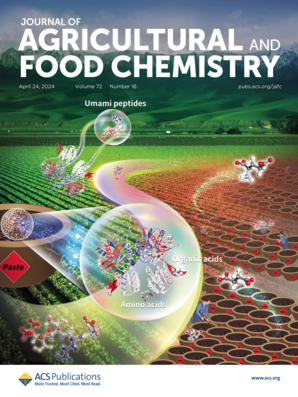Fucoxanthin Targets β1 Integrin to Disrupt Adhesion and Migration in Human Glioma Cells
IF 5.7
1区 农林科学
Q1 AGRICULTURE, MULTIDISCIPLINARY
引用次数: 0
Abstract
Glioblastoma, the most aggressive type of primary brain tumor, is marked by high invasiveness and metastasis, posing significant challenges in treatment. Fucoxanthin, a carotenoid derived from brown macroalgae, has demonstrated therapeutic potential in cancer therapy; however, its precise mechanisms of action remain unclear. In this study, we explored the inhibitory effects of fucoxanthin on integrin-mediated adhesion and migration in human glioma U-87 MG cells, shedding light on its potential antimetastatic properties. Our data indicated that fucoxanthin at 1 μM did not affect cell viability but inhibited integrin-mediated adhesion of human glioma U-87 MG cells to fibronectin, a key extracellular matrix (ECM) ligand for integrins, without affecting adhesion to poly-l-lysine, a nonintegrin ligand, indicating its selective impact on integrin-mediated adhesion. Fucoxanthin treatment significantly reduced the size and number of focal adhesions (FA), which play a central role in cell adhesion and migration. In addition, fucoxanthin significantly impaired U-87 MG cell migratory capacity, including a reduced accumulated migration distance and velocity, determined by time-lapse videomicroscopy. Further, fucoxanthin remarkably inhibited integrin engagement-mediated actin polymerization, Vav3 phosphorylation, and the downstream activation of Rac1, FAK, and paxillin, further supporting its role in disrupting integrin signaling and cytoskeletal remodeling. Additionally, complementary experiments utilizing protein binding assays, competitive ELISA, CETSA, DARTS, and MST collectively confirmed the direct interaction between fucoxanthin and β1 integrin as well as reduced ligand affinity of β1 integrin for fibronectin. The theoretical model of molecular docking and the dynamics simulation align with our experimental findings, providing a plausible mechanism by which fucoxanthin competitively inhibits the binding of β1 integrin to fibronectin. In summary, our study highlights fucoxanthin as a promising therapeutic agent that impairs integrin-mediated adhesion and migration in glioblastoma cells by directly targeting β1 integrin and disrupting integrin signaling pathways. These findings offer valuable insights into the potential of fucoxanthin as an antimetastatic agent in glioblastoma treatment.

求助全文
约1分钟内获得全文
求助全文
来源期刊
CiteScore
9.90
自引率
8.20%
发文量
1375
审稿时长
2.3 months
期刊介绍:
The Journal of Agricultural and Food Chemistry publishes high-quality, cutting edge original research representing complete studies and research advances dealing with the chemistry and biochemistry of agriculture and food. The Journal also encourages papers with chemistry and/or biochemistry as a major component combined with biological/sensory/nutritional/toxicological evaluation related to agriculture and/or food.

 求助内容:
求助内容: 应助结果提醒方式:
应助结果提醒方式:


